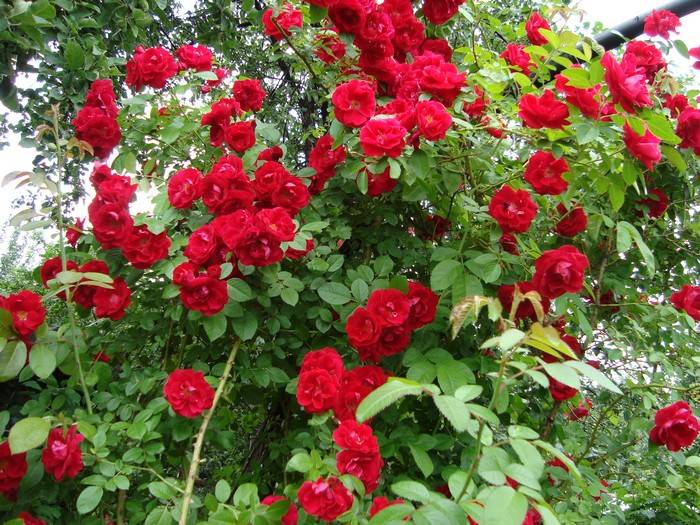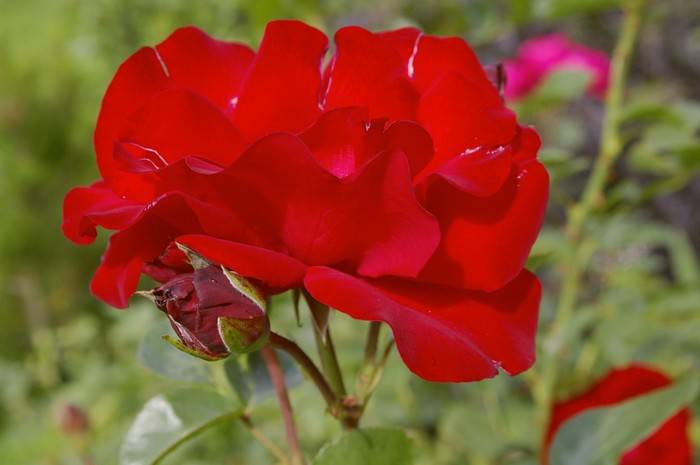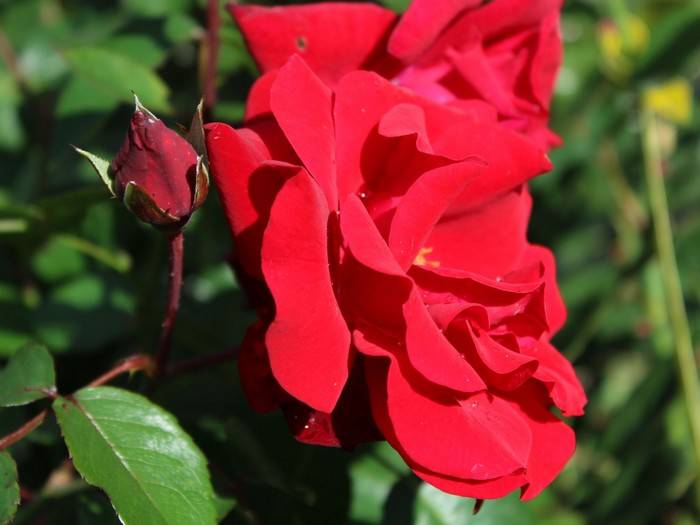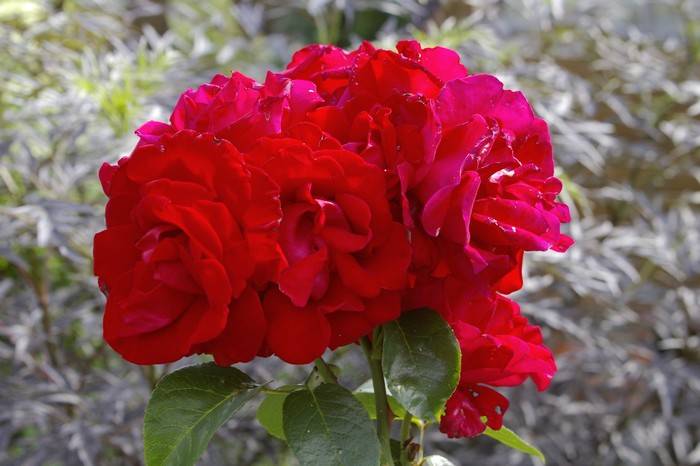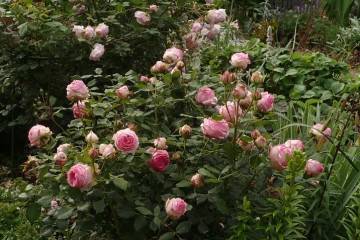Rose Santana (Santana) - characteristics of the variety
Content:
Climbing roses Santana look very impressive. On their shrubs with shiny foliage, large bright red flowers bloom in summer. The variety is re-flowering, therefore it pleases with its flowering from June to October.
Brief description of the variety
Bred by breeders of the German company Rosen Tantau in 1985 by crossing the varieties Max Graf and Vishurana.
For a landscape designer, the beauty Santana is a great tool. It is successfully used for vertical gardening using decorative supports and lattices. Arches and gazebos decorated with a flowering plant look spectacular. Bushes are often planted next to the fence. The plant pleases with its flowering until the end of October, and at the same time it is not capricious.
Santana rose quickly forms a strong and vigorous shrub up to 3 meters high, up to 2 m wide and with dense foliage. Thanks to the green and shiny leaves, the plant looks decorative even when not in bloom.
Santana flowers are bright red, double, large (up to 10 cm in diameter). The petals are velvety, delicate. Flowers are arranged in groups of up to 7 pieces per brush. They have a very pleasant and light aroma.
The advantages of the variety:
- resistance to cold and rain;
- abundant and friendly flowering;
- flowers do not fade for a long time;
- shoots are completely and evenly covered with inflorescences;
- long flowering period;
- thanks to the ability of the shoots to braid the support, like a liana, the plant is especially popular among landscape designers.
Disadvantages:
- low frost resistance, belongs to the 5th climatic zone (up to -29 degrees);
- weak aroma.
Basic landing rules
The planting of the climbing rose of Santana (sometimes called the Sonata climbing rose) is carried out by seedlings. When choosing seedlings, attention is paid to the following indicators: two or more strong healthy shoots should depart from the root collar, the rhizome should be powerful enough, without serious damage. It is recommended to disinfect the roots with copper sulfate (30g) or Fundazol (1 tablespoon per 10 liters of water) before planting.
For Santana, spring planting is preferable. It is produced in late April and early May. In the fall, it is more difficult to find the time for planting. It is important to plant the plant not too early so that the buds do not start growing, and not too late for it to take root. In autumn, planting can be scheduled for the third decade of September or the first decade of October.
Planting procedure step by step:
- A planting pit with a diameter of 50 cm and a depth of approximately 30-40 cm is being prepared.
- A drainage layer (expanded clay, gravel, broken brick, crushed stone) is poured into the bottom of the pit.
- Then humus is poured, 20 g of superphosphate, 15 grams of potassium salt.
- A seedling is being established.
- Sprinkled with prepared soil.
- Water abundantly.
- After planting, the shoots must be cut off, leaving about 20 cm above the ground. This will stimulate the growth of new shoots.
- If it is planned that the branches of a climbing rose will curl along the support, then it must be installed immediately.
Rose care
Plant care is essential for health, good growth and lush flowering. He needs to provide high-quality watering, mulching, feeding, loosening, pruning and protection for the winter.
Watering
The frequency of watering is determined by weather conditions and soil quality.It is advisable to water the rose in the morning or in the evening, on average once a week, 10 liters per 1 bush. Watering is done at the root. Roses are bad for watering with cold water. In September, watering of roses is stopped so as not to provoke growth.
Loosening
Loosening improves soil aeration. They loosen the ground to a depth of no more than 10 cm, deeper loosening can damage the roots of the plant.
Mulching
This agrotechnical technique solves several problems at once: it protects the soil under the bush from drying out and overheating, from weathering and freezing of the roots, and also, to some extent, from overgrowing with weeds. For mulching, grass, sawdust, straw, humus, pine needles are suitable.
Top dressing
The first two years after planting, the rose does not need additional feeding. From the third year, during the season, the bush is fed with mineral and organic fertilizers. The splendor of flowering does not to a small extent depend on the quantity and quality of the fertilizing carried out.
In spring, nitrogen fertilizers (mullein infusion, sodium humate, etc.) are relevant. They stimulate the growth of shoots. In summer and autumn, it is time to apply phosphorus-potassium fertilizers. They provide lush and long-lasting flowering. The last phosphorus-potassium top dressing is applied in October. This will allow the plant to strengthen the root system, increase its resistance to adverse weather conditions.
Pruning
Pruning is a must when growing a rose. Like all climbing roses, Santana needs pruning to maintain its decorative properties. Pruning allows you to form a bush. It is necessary to cut off the shoots that thicken it, as well as old and weak lashes. In the Santana variety, flowers are formed on last year's shoots, so they are left. During the growing season, the plant blooms twice, that is, the branch on which the flowers will grow takes about 3 years. From the fourth year, you can perform anti-aging pruning. Usually, several young shoots are left and no more than 7 flowering ones. A sharp knife, previously disinfected, is used for trimming. The cut must be treated with garden pitch.
Wintering features
In regions with mild climates, the Santana climbing rose hibernates without shelter. In the Middle Lane, the plant needs protection from frost, so the bush is cut off and covered when the temperature settles at -5 degrees.
Blooming rose
Santana blooms twice during the season. The first time the buds bloom in early June, and the second time - from mid-August until the first frost.
Care during and after flowering
During flowering, the plant needs regular watering, especially in hot and dry weather. After flowering, it is necessary to remove wilted flowers in a timely manner in order to stimulate the bush to form new buds.
What to do if it does not bloom
Possible reasons:
- wrong landing site;
- incorrect pruning;
- improper care;
- aging
If the wrong place for planting is chosen, then it is better to transplant the bush to a more suitable site. Choose a location that is sunny and protected from strong winds. Blooming in a sunny place will be lush and bright.
The bush may bloom poorly if pruned incorrectly (excessive) in the spring. A light, formative pruning should be applied. If the rose is overfed, it can begin to fatten, that is, it will direct all its forces to new shoots and foliage to the detriment of flowering.
If the bush on the site has been growing for more than 3 years, the oldest lashes should be cut off every year in the spring. In exchange, he will release new, young shoots, which will again delight with lush flowering.
Diseases and pests
The main pests are spider mites, green rose aphids, leafworms, scale insects, and others. The fight is carried out using periodic preventive treatment with insecticides.
Among the diseases are powdery mildew, black spot, bacterial cancer. For the timely detection of diseases, it is necessary to regularly inspect the bushes.
If the plant is affected by powdery mildew or black spot, it is necessary to remove the affected leaves as soon as possible and cut off the shoots. Timely help will allow you not to lose the bush completely.
Preventive measures consist in treating the bushes in the spring with a solution of copper sulfate. To increase resistance to diseases, phosphorus-potassium supplements are carried out.
Climbing Rose Santana is the royal decoration of the site. It is a great choice for the gardener.
